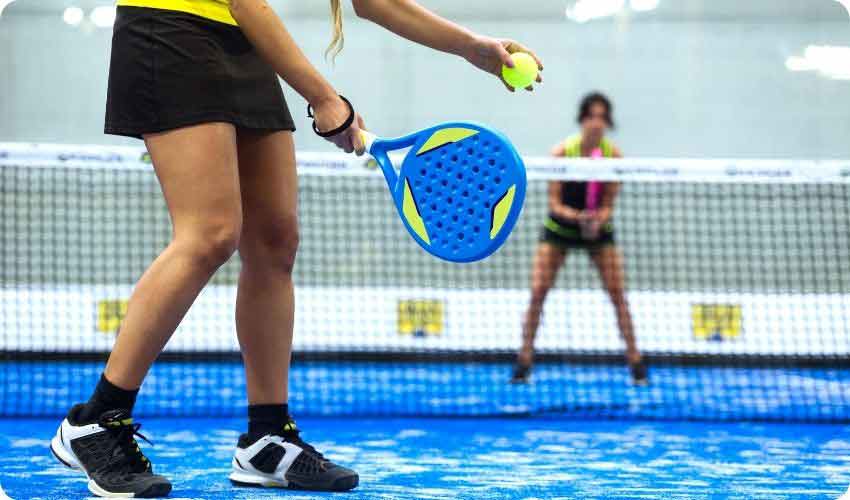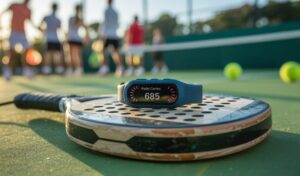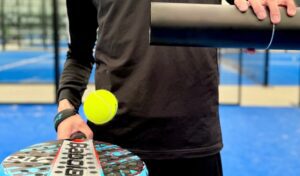Padel tennis is the new-to-the-world phenomenon – a fun, easy mix of tennis and squash. And if you don’t have much experience in racket sports or you want to try a different experience in your sporting life, A Beginner’s Guide on How to Play Padel Tennis will help you in getting to know the game from A to Z, from basics to more advanced tactics.
Introduction to Padel Tennis
Padel tennis is a distinct sport that was created in Mexico in the late 1960s and evolved into a world-renowned activity, especially in Spain and several European nations.
Essential Equipment
Here is what you need to get started with padel tennis:
- Paddle Bat: Padel rackets are solid with holes and do not have strings like tennis rackets and allow for much more maneuverability and ease of use.
- Balls: Like tennis balls, but a little less pressure, so they are slower and easier to control.
- Shoes: Game shoes with sufficient lateral support and non-marking soles for safety and performance.

Understanding the Court
A standard padel court is 20 meters long and 10 meters wide, surrounded by glass and mesh walls that are part of the game. A net divides the court and service lines defining the spaces for serving the ball. You can use the walls tactically when rallying, creating a more dynamic game.
Basic Rules and Scoring
In learning how to play padel tennis, you will enjoy the game (and also avoid embarrassing penalties). Firstly, understand the basic rules:
- Serve: The game starts with an underhand serve that lands diagonally in the opponent’s service box. The server must allow the ball to bounce behind the service line and hit it below waist high.
- How to score in the game of padel? You score when the ball bounces twice on the other side, and precise lobs or low shots are vital for creating unreturnable plays. Another way to score points is through opponent errors – for example, hitting the ball into the net, or hitting it outside the play area (out of the cage, or off of your walls). Also take advantage of self-inflicted errors, such as when foes belting a ball into their own grid (metal fencing) or if the ball hits a rival mid-point.
- Padel Tennis has the same scoring system as tennis: 15, 30, 40, game. When a team is at 40-40 (deuce), they need to win two points in a row to win the game. Matches are usually best of three sets, with each set requiring six games, with a two-game margin, to win.
- Ball in Play: The ball must bounce on the floor before the walls. Players can volley (hit the ball before it bounces) or play it off the walls on their end. If the ball hits the wall on the opponent’s side without first bouncing on the ground, the ball is out.
Fundamental Techniques
When you learn at least some of the basic strokes, your gameplay will improve:
- Watch a short video on How to play Padel,
- Forehand and Backhand: These groundstrokes are also common in tennis, and important for rally and passing shots.
- Volley: A technique typically employed at the net to intercept and redirect the ball with minimal bounce.
- Lob: Defensive shot hit up and over opponents to push them back off the net.
Padel Tennis Serves
The serve is the tone of each point:
- Preparation: Stand behind the service line – exert down to the ball.
- Execution: After the bounce, strike the ball around waist high diagonally in the service box on the opponent’s side.
- Faults: A serve is a fault if it doesn’t land in the correct service box, fails to hit the net and cross, or hits the wire fence after the first bounce. If the first serve is a fault, players are given a second serve.
Padel Wall Rules and Usage
A must-know to keep a fair play and strategy. In padel, the ball is supposed to bounce on the court before hitting the wall; if it strikes the wall first, it does not count. It can then bounce around a couple of times off the walls before this. On serves, the ball is required to land in the opponent’s serve box and can bounce off the wall, but cannot hit the fence – striking the fence cancels the serve, offering a second attempt. From ball bounce elaborations to serving stipulations, these concepts cover every aspect of the game to maximize play by combining accuracy with wall play.
Gameplay Strategies on how to play padel tennis
Good strategies can set you apart:
- Communication: Always work together with your partner to ensure the court is covered properly.
- Positioning: Net position to control the point, but ready to pull when necessary.
- Patience: Use your placement and play smart to construct points instead of playing out of power.
Common mistakes to avoid in padel
Be mindful of these pitfalls:
- Over hitting the Ball: New players often want to hit the ball hard, but in padel, placement and control are more essential than power.
- Neglecting the Walls – when you play tennis, the walls are out of the equation. How to use them to your advantage can improve your game.
- Incorrect Court Positioning: If you have the bad habit of hanging around the same distance from the baseline or the net for too long, you risk falling vulnerable to attacks from the opposition. Be mindful with your positioning.
- No Communication: When at the net in doubles, expecting your partner to chase down everything will lead to needless mistakes. Have someone call out shots and agree on who covers what.
Mastering the art of padel shots
After you know how to play padel tennis, adding in advanced shots to your more general gameplay can give you plenty of advantages over your competitors.
- Bandeja: A defensive overhead shot used to stay in control of the rally. It’s delivered with a smooth, slicing action to keep opponents from attacking aggressively.
- Víbora: A topspin heavy shot that remains low and speeds over the net, making it a tough shot for opponents to respond to. And it’s a good way to hit through errors and maintain control of the point.
- Chiquita: A soft drop shot barely clearing the net for drop shotsす→ lure your opponents in and a big drop shot4 And this is especially effective against deep dwelling players.
Padel Tips and Tricks
- Nail the Basics: Use the continental grip for variety in your shots, knees bent and low. Focus on footwork – work on split-stepping and speedy lateral movement to stay light on your feet.
- Dominate the Net: Be super aggressive on the net to apply pressure on opposing players. Volley at an angle wide or establish a bandeja (defensive lob) to reset the rallies. Don’t hang out at the back; it restricts your choices.
- Use Walls Wisely: Use the transparent walls to your advantage. Hit chiquitas (soft wall shots) to jam rhythm, and practice rebounds off the back wall to add a spin and a time-store.
- Precision, power and mix in dropshots to bring them forward and high full shots to bring them back. Learn to hit the víbora (angled spin smash) for winners. Don’t hit too hard – control gets the point.
Improve your Padel Strategy
- Communicate constantly: In doubles, shout “yours” or “mine” to prevent collisions. Mid-rally switch sides to counter the gaps-tandem action beats solo prowess.
- Stay Patient & Adapt: Choose your moment to unleash your wrath If you are behind, keep your cool; solid plays consistently beat the colorful shots. Take action by changing strategies if weaknesses are picked at by the enemies.
- Best Padel Drills for Beginners – Target Practice on Drill wall, rallies, reflexes and progression against different opponents. Film matches to identify weaknesses, such as weak backhands or predictable serves. Read the article Padel Training at Home.
- Read Opponents: Notice the angle of their paddle, and their stance. Crowding the net? Use lobs. Staying back? Drop shots or low volleys leave them scrambling.

Conclusion
Padel tennis is an exciting, engaging, and social sport that combines strategy, skill, and fun. Whether you’re new to the game or looking to refine your skills, mastering the rules, learning the basics, and applying key tips for padel tennis will transform you into a formidable player. From perfecting your backhand glass shot to positioning smartly in doubles, these tips for padel tennis can elevate your game dramatically. So grab your racket, hit the court with friends, and dive into the thrill of the game – the most important step is getting started! With consistent practice and these essential tips for padel tennis, you’ll be joining Padel tournaments faster than you think!
Do you wish to boost your Padel Game Plan? For additional insight of the sport and any Padel advice, keep your eyes peeled at PadelGamePlan.com!
FAQ – FACTS ABOUT PADEL TENNIS
What is the difference between padel and tennis?
The game is played on a smaller, enclosed court with walls and solid rackets without strings. The serve is also underhand, and the ball can bounce off walls, making it more action-oriented than regular tennis.
Can you play padel using a standard tennis racket?
No, padel uses a solid racket with perforations specifically developed to fit the enclosed court, helping improve your overall gameplay.
How long is a padel match?
Depending on the players’ skill levels and match format, matches last about 45 minutes to 1.5 hours.
How to find my nearest padel court?
Padel courts are increasingly common. Use search engines, local sports centers, padel clubs, or online directories to see where you can play in your vicinity.
FAQ – PADEL IMPROVEMENT
How to get better at padel?
You will need regular practice, hit on the walls and watch matches of professionals. Read this Article – Padel Training at Home.
How can I improve my Service?
For more information on Padel Service, please read the Article – Best Padel Serve Techniques
Can I know more about the Rules of Padel Tennis?
Absolutely, for a beginner-friendly explanation of the Rules of Padel Tennis, please have a look at the Article – Rules of Padel Tennis. For Official Rules, please download the official rules of Internatlonal Padel Federation here.
FAQ – PADEL FOR CHILDREN
At what age should children start Padel Tennis for children?
Children as young as 4 can start out with foam balls and mini-rackets. The majority of clubs are for ages 5–15.
How does padel improve teamwork in kids?
Doubles requires constant communication and mutual strategies; collaboration is natural.
Can padel help academically?
Doubles requires constant communication and mutual strategies; collaboration is natural.
What is a good reason why padel is safer than tennis for little kids?
Enclosed courts, slower balls, and lighter gear reduce injury risks significantly.
Is there any competitive padel opportunity for kids?
Absolutely! Try to look for Junior leagues that offer Padel tournaments for under-12 and teen divisions. the positive impact of padel tennis on children
FAQ – PADEL EQUIPMENT
Do I need special padel tennis attire?
Please read the Article – Top Padel Clothing Essentials.
Do you have a checklist of padel tennis essentials I’ll need?
Could you recommend which padel balls I should use?
Please read the Article – Best Padel Balls.
Planning a Padel Tournament?
Use our Free Tool and get the schedule in seconds.
FAQ – PADEL TENNIS COURT
Is it possible to erect a padel court in my garden?
Installation is possible with a minimum area of 10m × 20m, subject to local zoning approval. For more information, Read this Article.
How much the cost of a padel court?
A typical padel court can range from AED 335,000 to AED 1,113,000, depending on materials, location and amenities. See the full cost breakdown here: Article – How much does it cost to build a padel court.
What about lighting required for the padel court – what advice can you give on that?
Please have a read through on the Article – Essential Padel Lighting Tips.







11 Responses